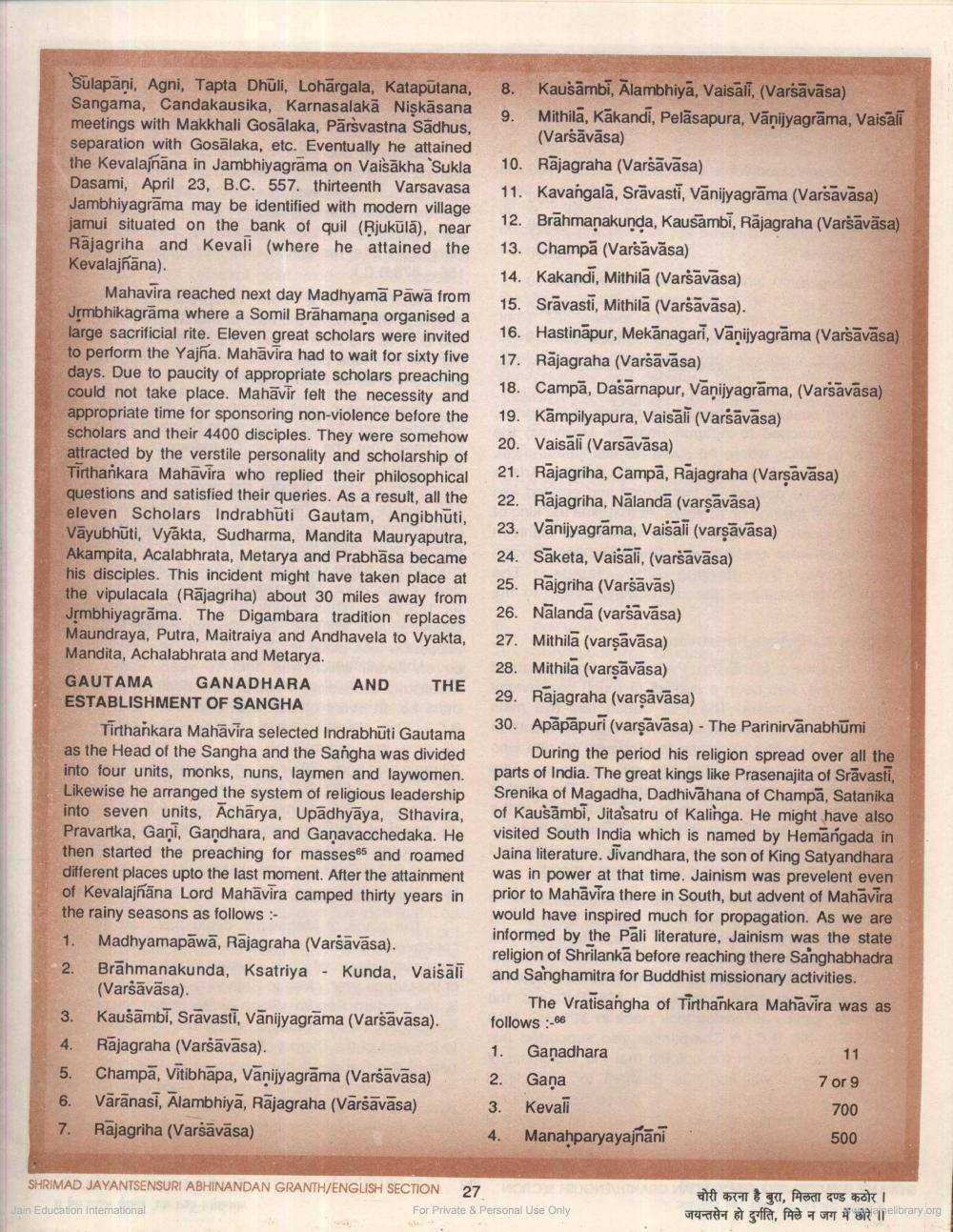________________
Sulapani, Agni, Tapta Dhuli, Lohārgala, Kataputana, Sangama, Candakausika, Karnasalakā Niskāsana meetings with Makkhali Gosālaka, Pārsvastna Sädhus, separation with Gosālaka, etc. Eventually he attained the Kevalajnana in Jambhiyagrama on Vaisakha Sukla Dasami, April 23, B.C. 557. thirteenth Varsavasa Jambhiyagrāma may be identified with modern village jamui situated on the bank of quil (Rjukülā), near Rajagriha and Kevali (where he attained the Kevalajñāna).
Mahavira reached next day Madhyamā Pāwā from Jrmbhikagrāma where a Somil Brāhamana organised a large sacrificial rite. Eleven great scholars were invited to perform the Yajha. Mahāvira had to wait for sixty five days. Due to paucity of appropriate scholars preaching could not take place. Mahavir felt the necessity and appropriate time for sponsoring non-violence before the scholars and their 4400 disciples. They were somehow attracted by the verstile personality and scholarship of Tirthankara Mahavira who replied their philosophical questions and satisfied their queries. As a result, all the eleven Scholars Indrabhuti Gautam, Angibhuti, Vāyubhuti, Vyakta, Sudharma, Mandita Mauryaputra, Akampita, Acalabhrata, Metarya and Prabhāsa became his disciples. This incident might have taken place at the vipulacala (Rājagriha) about 30 miles away from Jrmbhiyagrāma. The Digambara tradition replaces Maundraya, Putra, Maitraiya and Andhavela to Vyakta, Mandita, Achalabhrata and Metarya. GAUTAMA GANADHARA AND THE ESTABLISHMENT OF SANGHA
Tirthankara Mahavira selected Indrabhūti Gautama as the Head of the Sangha and the Sangha was divided into four units, monks, nuns, laymen and laywomen. Likewise he arranged the system of religious leadership into seven units, Achārya, Upādhyāya, Sthavira, Pravartka, Gani, Gandhara, and Ganavacchedaka. He then started the preaching for masses65 and roamed different places upto the last moment. After the attainment of Kevalajñana Lord Mahävira camped thirty years in the rainy seasons as follows :1. Madhyamapāwā, Rājagraha (Varšāvāsa). 2. Brāhmanakunda, Ksatriya - Kunda, Vaisali
(Varšāvāsa). 3. Kaušāmbi, Srāvastī, Vānijyagrama (Varšavāsa). 4. Rājagraha (Varšāvāsa). 5. Champā, Vitibhāpa, Vanijyagrāma (Varšavāsa)
Vārānasi, Alambhiyā, Rājagraha (Värsavāsa) 7. Rajagriha (Varšāvāsa)
8. Kaušāmbi, Alambhiyā, Vaisali, (Varšāvāsa) 9. Mithila, Kākandi, Pelāsapura, Vānijyagrāma, Vaisāli
(Varšāvāsa) 10. Rājagraha (Varšāvāsa) 11. Kavangalā, Srāvasti, Vānijyagrāma (Varsavāsa) 12. Brāhmanakunda, Kausambi, Rājagraha (Varšāvāsa) 13. Champā (Varšāvāsa) 14. Kakandi, Mithila (Varšavāsa) 15. Srāvasti, Mithila (Varšāvāsa). 16. Hastinapur, Mekānagari, Vānijyagrāma (Varšāvāsa) 17. Rājagraha (Varšāvāsa) 18. Campā, Dasārnapur, Vānijyagrāma, (Varšāvāsa) 19. Kāmpilyapura, Vaisāli (Varšāvāsa) 20. Vaisāli (Varsāvāsa) 21. Rājagriha, Campā, Rājagraha (Varşāvāsa) 22. Rājagriha, Nālandā (varşāvāsa) 23. Vānijyagrāma, Vaisali (varşāvāsa) 24. Sāketa, Vaisali, (varšavāsa) 25. Rājgriha (Varšāvās) 26. Nālandā (varšāvāsa) 27. Mithilā (varşāvāsa) 28. Mithila (varsāvāsa) 29. Rajagraha (varşāvāsa) 30. Apāpāpuri (varşavāsa) - The Parinirvānabhumi
During the period his religion spread over all the parts of India. The great kings like Prasenajita of Srāvasti, Srenika of Magadha, Dadhivāhana of Champā, Satanika of Kaušāmbi, Jitasatru of Kalinga. He might have also visited South India which is named by Hemangada in Jaina literature. Jivandhara, the son of King Satyandhara was in power at that time. Jainism was prevelent even prior to Mahāvira there in South, but advent of Mahavira would have inspired much for propagation. As we are informed by the Pali literature, Jainism was the state religion of Shrilankā before reaching there Sanghabhadra and Sanghamitra for Buddhist missionary activities.
The Vratisangha of Tirthankara Mahavira was as follows : 66 1. Ganadhara
11 2. Gana
7 or 9 3. Kevali
700 4. Manahparyayajñāni
500
SHRIMAD JAYANTSENSURI ABHINANDAN GRANTH/ENGLISH SECTION 27 Jain Education International
For Private & Personal Use Only
चोरी करना है बुरा, मिलता दण्ड कठोर । 74494 e goffa, fed a
library org




